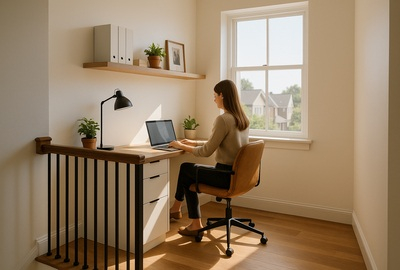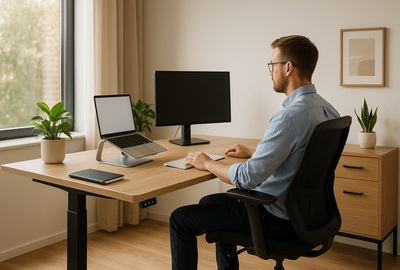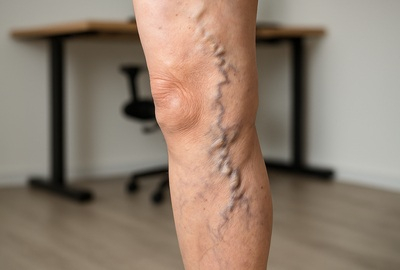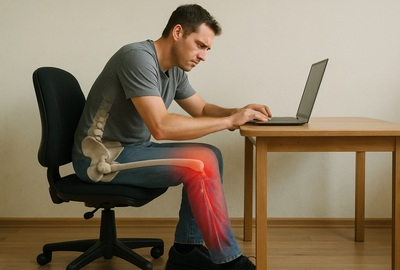1. Boost Productivity
Standing encourages movement, and movement keeps your brain switched on. When you're upright, you’re less likely to zone out or slump into that 3pm brain fog. Think of it as a productivity nudge, not a magic fix.
Actionable Tips:
- Alternate between sitting and standing every 30–60 minutes.
- Use a reminder app or timer to prompt posture changes.
- Start small: try standing for two 30-minute intervals per day and build from there.
Real-World Example: Amy, a freelance graphic designer in Melbourne, reported finishing tasks 20–30% faster once she started using a sit-stand desk. "I feel less stuck, mentally and physically," she said.
2. Improve Posture
Hours in a cheap chair hunched over a laptop? That’s a fast track to poor posture. Standing desks can help reset your spinal alignment—if used properly.
Posture Checklist for Standing Desk Users:
- Screen at eye level, about an arm's length away
- Elbows at a 90-degree angle, wrists straight
- Weight evenly distributed between both feet
- Avoid locking your knees
Extra Tip: Invest in an anti-fatigue mat. It encourages micro-movements that reduce strain on your joints and lower back.
3. Reduce Back Pain
One of the top standing desk health benefits is less back pain. Too much sitting compresses the discs in your spine, especially in the lower back.
Quick Fixes:
- Try 20 minutes standing after every meal.
- Use a footrest or low box to alternate foot elevation—this takes pressure off your lower back.
- Mix in light stretching or shoulder rolls throughout your day.
What We Hear from Deskup Customers: Back pain is often the first thing people mention when they call us. Many say the pain goes from a constant 7/10 to a dull 2/10 after a few weeks of sit-stand use.
4. Increase Energy
Standing keeps your body more engaged and responsive. Instead of slouching into a post-lunch slump, you’re more likely to feel alert and ready to tackle the next task.
How to Use Standing for a Quick Energy Boost:
- Stand during calls or video meetings.
- Switch to standing in the early afternoon to avoid the post-lunch crash.
- Try “walk and think” breaks—standing desks with castors make this even easier.
5. Enhance Focus
Small movements throughout the day can sharpen your mental clarity. Standing encourages these micro-adjustments, which help combat mental fatigue.
Ideas to Improve Focus:
- Keep a small balance board or foot rocker under your desk.
- Switch to standing during complex tasks like writing or coding.
- Use noise-cancelling headphones while standing to minimize distractions.
Mini Case Study: Tom, a developer based in Brisbane, said his concentration improved dramatically when he began alternating between sitting and standing each hour. “I don’t get mentally tired as quickly,” he shared.
6. Support Weight Management
Standing won’t replace the gym, but it can support your weight goals. You’ll burn more calories than sitting and naturally incorporate more movement into your day.
Simple Ways to Add Movement:
- March or shift weight side-to-side while standing.
- Use a desk treadmill or under-desk stepper for low-impact motion.
- Stand while checking emails, attending webinars, or doing admin work.
Fun Fact: Standing burns about 50 more calories per hour than sitting. That’s 250 extra calories over a 5-hour standing window.
7. Lower Risk of Disease
The phrase "sitting is the new smoking" exists for a reason. Long-term sitting has been linked to:
- Type 2 diabetes
- Cardiovascular disease
- Certain cancers
- Early mortality
Standing Desk Benefits for Long-Term Health:
- Improves blood sugar response after meals
- Lowers resting heart rate
- Reduces triglyceride levels (a risk factor for heart disease)
Health Hack: Pair your standing desk with a hydration goal. Standing makes it easier to remember to get up and refill your water bottle.
8. Promote Longevity
The benefits of a sit-stand desk go beyond daily comfort. Reducing sedentary time may actually help you live longer. Research suggests adults who sit less than three hours per day may extend their lifespan by up to two years.
Long-Term Use Tips:
- Create a sit-stand habit by pairing it with daily triggers (e.g., stand while on your first Zoom call).
- Review your setup every 3–6 months to keep ergonomics in check.
- Gradually increase your standing time—don’t try to go all day on Day One.
9. Shop Smart: Choose a Trusted Australian Company
Thinking about upgrading your workspace? Choose a company that understands local needs and delivers fast.
At Deskup, we know standing desks inside and out. We’ve supplied thousands of home offices, co-working spaces, and full corporate fitouts across Australia.
Why Deskup?
- Locally Stocked: No waiting for overseas deliveries—everything ships same-day from our Aussie warehouse.
- Built for Work: Our L-shape electric desks handle up to 140kg—ideal for multi-monitor setups and commercial use.
- Affordable Options: Great pricing without the quality shortcuts.
- Support You Can Call: Real humans who actually use the desks we sell.
Popular Picks:
- EconoRise™ Laptop Riser – Perfect starter for occasional standers
- FlexiLift™ Dual Motor Desk – Smooth, silent, and solid
- ProForm™ L-Shape Desk – Heavy-duty workspace for serious setups
Final Thoughts: Are Standing Desks Good for You?
The short answer? Yes—if used correctly. Standing desks aren't a cure-all, but they're a powerful tool in building a healthier, more productive work life. Think of it as upgrading from a typewriter to a modern PC. Same work. Just smarter tools.
Next Steps:
- Visit Deskup Australia to browse the range
- Chat with our team to find the right desk for your space
- Get started with better habits that support your body and workflow
Need help picking the right desk? Reach out to Deskup today. We’ll help you find the setup that suits your budget, space, and style—without the guesswork.


 Buy Now, Pay Later
Buy Now, Pay Later Verified Rating
Verified Rating 




